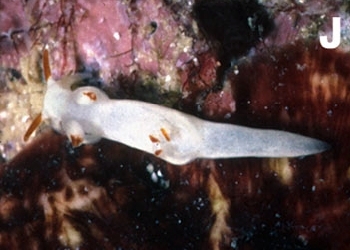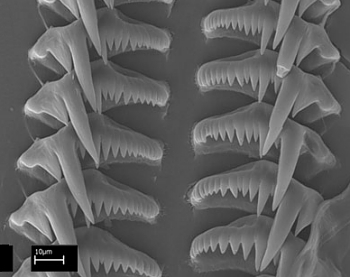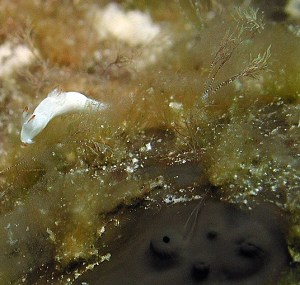

Trapania vitta
Gosliner & Fahey, 2008
Order: NUDIBRANCHIA
Suborder: DORIDINA
Superfamily: ANADORIDOIDEA
Family: Goniodorididae
DISTRIBUTION
Known from Indonesia, Papua New Guinea, the Philippines and southernJapan.
PHOTO
Upper: CASIZ 172861, Bali, Indonesia, 3 mm. Photo: T. Gosliner. Lower: CASIZ 172861. Radular morphology. Scale =10 µm. [From Gosliner & Fahey 2008: Fig 20C].
This species is described as having a white body, including white tentacular anterior foot corners and white dorso-lateral processes. The oral tentacles have a white base but are primarily orange, the gills are white with orange edging on the dorsal side, and the rhinophores clubs are similarly white with orange at the tip and down the dorsal surface. The posterior tip of the foot is described as having "an occasional orange pigment spot". The largest animals examined by Gosliner & Fahey were 5 mm long alive.
Gosliner & Fahey describe the radular morphology of T. vitta as closely resembling that of T. aurata Rudman, 1987 from Hong Kong "but the outermost denticle of T. aurata is longer with a base that extends the entire width of the tooth ". I don't know what they mean by that, as when I compare SEM photos of T. aurata from both Hong Kong [message #21436] and New Caledonia [message #21437 ] I can see no real difference.
Some animals previously identified on the Forum as T. cf aurata [message #313] and some identified as T. aurata [#17725, #1569] appear to match the colour pattern of T. vitta. See Trapania cf. aurata for animals with slightly different colour pattern, which may or may not be variants of this species. See also discussion [#21438 ] concerning the similarly coloured T. aurata, and message #9599 concerning Trapania sp. 8.
-
Gosliner, T.M. & Fahey, S.H. (2008) Systematics of Trapania (Mollusca: Nudibranchia: Goniodorididae) with descriptions of 16 new species Systematics and Biodiversity, 6 (1): 53-98
Rudman, W.B., 2008 (March 10) Trapania vitta Gosliner & Fahey, 2008. [In] Sea Slug Forum. Australian Museum, Sydney. Available from http://www.seaslugforum.net/find/trapvitt
Related messages
Trapania vitta? from sthn Queensland
March 18, 2008
From: Gary Cobb


Concerning message #9599:
So Bill is this animal in fact Trapania vitta?
Locality: Rockwall ledges, Mooloolaba , 2m, Queensland, Australia, Pacific Ocean, 8 October 2005, Subtidal. Length: 6mm. Photographer: Gary Cobb.
Gary Cobb
gary@nudibranch.com.au
Cobb, G.C., 2008 (Mar 18) Trapania vitta? from sthn Queensland. [Message in] Sea Slug Forum. Australian Museum, Sydney. Available from http://www.seaslugforum.net/find/21450
Thanks Gary,
I'm glad to see the Trapania story is continuing to grow. Your animal certainly looks like T. vitta, but the point I have been trying to make is that it is not a good idea to be too 'sure' in identifying some of these species. To say "This is in fact T. vitta" suggest there is some book or supreme database with all the correct answers - but there isn't. I don't know if the intermediate colour patterns mean there is one variable species, two species with overlapping colour patterns or perhaps three or four species. Personally I would find the existence of a 'big book' with all the answers rather depressing. I prefer being able to stumble around discovering new bits of information -some small, some larger - but all very exciting
Best wishes,
Bill Rudman
Trapania vitta? from the Philippines
March 14, 2008
From: Erwin Köhler

Dear Bill,
Here is one more picture from the Philippine Islands.
Siquijor Island, divesite "Paliton Wall", Philippine Islands. Length: 11mm. Depth: 8 m. 08 March 2003
Cheers,
Erwin
Erwin@medslugs.de
Köhler, E., 2008 (Mar 14) Trapania vitta? from the Philippines. [Message in] Sea Slug Forum. Australian Museum, Sydney. Available from http://www.seaslugforum.net/find/9599
Dear Erwin
This is another message from a few years ago. As I discuss separately [message #21438] I have some difficulty distinguishing T. aurata and T. vitta. The absence of orange on the extra-rhinophoral and extra-branchial processes seems to fit the description of T. vitta, but if there are two species, then the general body shape and relatively fine orange markings on the rhinophores and gills would suggest T. aurata.
In my earlier discussion I should have mentioned Trapania sp. 8. Is it just another colour form of one species? It has orange rhinophores, oral tentacles, tentacular foot corners, extra-rhinophoral and extra-branchial processes and a large orange line on the posterior tip of the foot. The gills are white. The orange on the extra-rhinophoral and extra-branchial processes differs from what we see in T. aurata in that the orange pigment covers the whole of the process, not just a dorsal line.
Best wishes
Bill Rudman
Trapania aurata in East Timor
September 4, 2006
From: Brian Francisco

Note added 12 March 2008: This is probably the species which has recently been named Trapania vitta as it lacks orange on the dorso-lateral processes but differs in having orange on anterior foot corners.
Hi Bill
We believe this is Trapania aurata.
Locality: Tasi Tolu, 13 meters, East Timor, Banda Sea, 2 September 2006, Sandy slope. Length: 6 mm. Photographer: Brian Francisco.
Thanks
Brian
www.uwet.net
francisco.brian@gmail.com



Dear Brian,
Yes this is T. aurata. One interesting thing is that it is on this dysideid sponge. As you will see if you look a the other species of Trapania on the Forum is that they are often found on similar sponges. In my earlier message on this species [#3774] - where I mistakenly identify the sponge as an aplysillid - I mention the little whitish blobs on stalks which are probably the entoproct food of the nudibranch. If you look carefully at your photos you will see small out of focus white blobs which are most likely the same thing. It seems all species of Trapania feed on entoprocts living on these sponges.
Best wishes,
Bill Rudman
Trapania aurata from Vanuatu
December 12, 1999
From: Vinka Stenhouse

Note added 12 March 2008: This is possibly the recently named species Trapania vitta but it is hard to see colour pattern.
Dear Bill,
Here is another nudibranch from Espiritu Santo Is., Vanuatu, 1997. It was found on sponge at 2 metre depth. 8 mm long.
Yours sincerely,
Vinka Stenhouse.
Santo.
Vanuatu.
Dear Vinka,
This is Trapania aurata. A puzzling feature of species of Trapania is we don't know what they eat. Sometimes they are found in quite large numbers, usually on a sponge which would suggest they are sponge-feeders. However the shape of their radular teeth is quite unlike that of any other group of sponge feeders, and they are related to animals which feed on bryozoans.
This mystery is quite similar to the mystery surrounding the food of species of the Gastropteridae (Sagaminopteron, Siphopteron, Gastropteron). The are also commonly found on sponges but have radular teeth similar in shape to the related philinoid bubble-shells such as Philine.
Best wishes,
Bill Rudman.
Trapania aurata? from Bali
November 17, 1998
From: Michael Miller

Note added 12 March 2008: These specimens match the recently named species Trapania vitta.
Bill
Picking up once again on the thread dealing with Trapania, you will find an attached pic of what is believed to be Trapania aurata (Colemans's Field
Guide).
A number of these animals were seen at Tulamben, Bali, Indonesia. None were collected as they correlated rather closely with the picture in Coleman's Nudibranchs of the South Pacific.
Cheers;
Mike Miller
mdmiller@cts.com
Miller, M.D., 1998 (Nov 17) Trapania aurata? from Bali. [Message in] Sea Slug Forum. Australian Museum, Sydney. Available from http://www.seaslugforum.net/find/313Dear Mike,
Thanks for the picture. I'm sorry you didn't collect some specimens as I have my doubts whether they are the same. Its not just that the Bali specimens are more reddish orange than yellow, but they lack any colour on their lateral processes.
Neville Coleman's illustrated specimens are probably the same as yours with no sign of colour on the lateral processes.
If you find them again I wouldn't mind having a look at some.
Best wishes,
Bill
